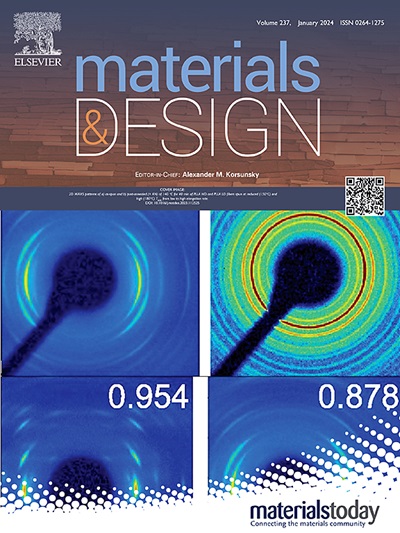Ultrafast carbothermal shock synthesis of submicron high-entropy carbides: Dual enhancement of oxidation resistance and microwave absorption
IF 7.6
2区 材料科学
Q1 MATERIALS SCIENCE, MULTIDISCIPLINARY
引用次数: 0
Abstract
Improvement in both the oxidation resistance and microwave absorption of ceramic materials is crucial for advancing their aerospace applications in extreme thermal and electromagnetic environments. Here, submicron-scale (∼440 nm) five- and eight-cation high-entropy carbides (HECs) were rapidly synthesized via the carbothermal shock method. This non-equilibrium synthesis process resulted in HECs with amorphous carbon interfaces and significant lattice distortion, endowing them with superior oxidation resistance and microwave absorption properties. The oxidation onset temperature was found to be 565 °C, with a minimum reflection loss of −43 dB and an effective absorption bandwidth of 5.12 GHz at a thickness of 1.2 mm. Additionally, a reduction in radar cross-section of more than 30 dBm2 was also observed. This enhanced performance is attributed to the fact that the amorphous carbon phase acts both as an oxygen protective barrier and a conductive network, thereby promoting electrical conduction loss. Furthermore, the lattice distortion-induced vacancy defects enhance both the polarization and conduction losses of the ceramics. This study demonstrates an effective and scalable strategy for enhancing both oxidation resistance and electromagnetic wave absorption properties of ceramic materials.

亚微米高熵碳化物的超快碳热冲击合成:抗氧化和微波吸收双重增强
提高陶瓷材料的抗氧化性和微波吸收性对于推进其在极端热和电磁环境中的航空航天应用至关重要。在这里,通过碳热冲击法快速合成了亚微米尺度(~ 440 nm)的5 -阳离子和8 -阳离子高熵碳化物(HECs)。这种非平衡合成过程导致HECs具有非晶碳界面和显著的晶格畸变,使其具有优异的抗氧化性能和微波吸收性能。氧化起始温度为565℃,最小反射损耗为- 43 dB,有效吸收带宽为5.12 GHz,厚度为1.2 mm。此外,还观察到雷达横截面减少超过30 dBm2。这种增强的性能归因于无定形碳相既作为氧保护屏障又作为导电网络,从而促进导电损失。此外,晶格畸变引起的空位缺陷增加了陶瓷的极化和传导损失。本研究为提高陶瓷材料的抗氧化性和电磁波吸收性能提供了一种有效的、可扩展的策略。
本文章由计算机程序翻译,如有差异,请以英文原文为准。
求助全文
约1分钟内获得全文
求助全文
来源期刊

Materials & Design
Engineering-Mechanical Engineering
CiteScore
14.30
自引率
7.10%
发文量
1028
审稿时长
85 days
期刊介绍:
Materials and Design is a multi-disciplinary journal that publishes original research reports, review articles, and express communications. The journal focuses on studying the structure and properties of inorganic and organic materials, advancements in synthesis, processing, characterization, and testing, the design of materials and engineering systems, and their applications in technology. It aims to bring together various aspects of materials science, engineering, physics, and chemistry.
The journal explores themes ranging from materials to design and aims to reveal the connections between natural and artificial materials, as well as experiment and modeling. Manuscripts submitted to Materials and Design should contain elements of discovery and surprise, as they often contribute new insights into the architecture and function of matter.
 求助内容:
求助内容: 应助结果提醒方式:
应助结果提醒方式:


